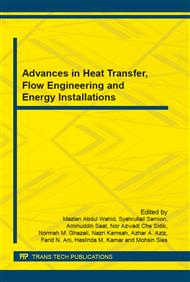p.46
p.58
p.63
p.69
p.74
p.78
p.83
p.88
p.94
Effectiveness of Jet Impingement Cooling System on Convex Surface
Abstract:
Jet impingement is one of cooling method used in order to achieve high heat transfer coefficient and widely used in industry applications such as drying of textile and film, glass and plastic sheets, cooling of electronic equipment, and heat treatment of metals. In this research, it focused on the effectiveness of the jet impingement cooling system on the convex surface based on mass blowing rate and nozzle exit to surface parameters. The scope of experiment research encompasses are convex surface made of aluminum alloy and diameter 12.5cm. For mass blowing rate parameters, it use ʋjet = 1.98m/s, 3.03m/s, 4.97m/s and 6.00m/s which has Reynolds number range from 643 until 1946. Nozzle exit to surface distance,s/d = 4.0, 8.0 and 12.0. In this experiment model, a major components that involved are a compressor, nozzle, convex surface model, K thermocouple and heater. For the result of the experiment, it is based on the data obtain through a heat transfer coefficient and Nusselt number which the plotted graph focus on the space spacing and Reynolds number parameters. For the graph Nusselt number versus s/d at stagnation point c/d=0, it shown that when the Reynolds number increase, the Nusselt number also increase. In term of effectiveness, the s/d=12.0 has a good effectiveness jet impingement cooling system. For the graph of Nusselt number versus Reynolds at stagnation point, c/d=0, as Reynolds number increase, the Nusselt number increase too. From this experiment the better cooling effect is at Reynolds number, Re=1946. Thus, it can conclude that, effectiveness for jet impingement cooling system on the convex surface occurs at the highest Reynolds number.
Info:
Periodical:
Pages:
74-77
Citation:
Online since:
January 2016
Authors:
Keywords:
Price:
Сopyright:
© 2016 Trans Tech Publications Ltd. All Rights Reserved
Share:
Citation:


